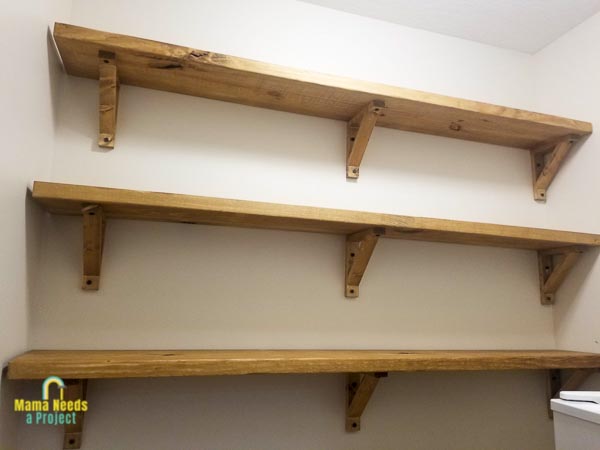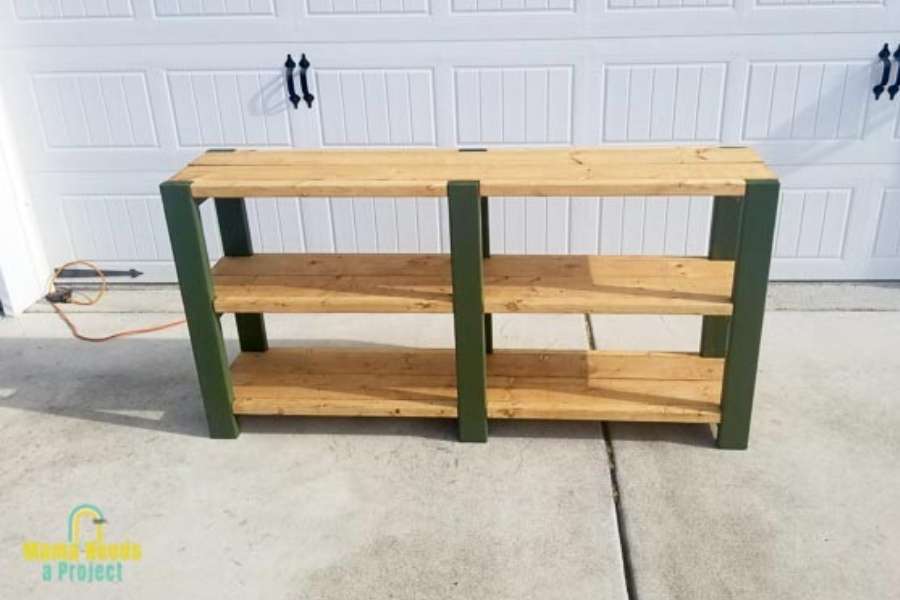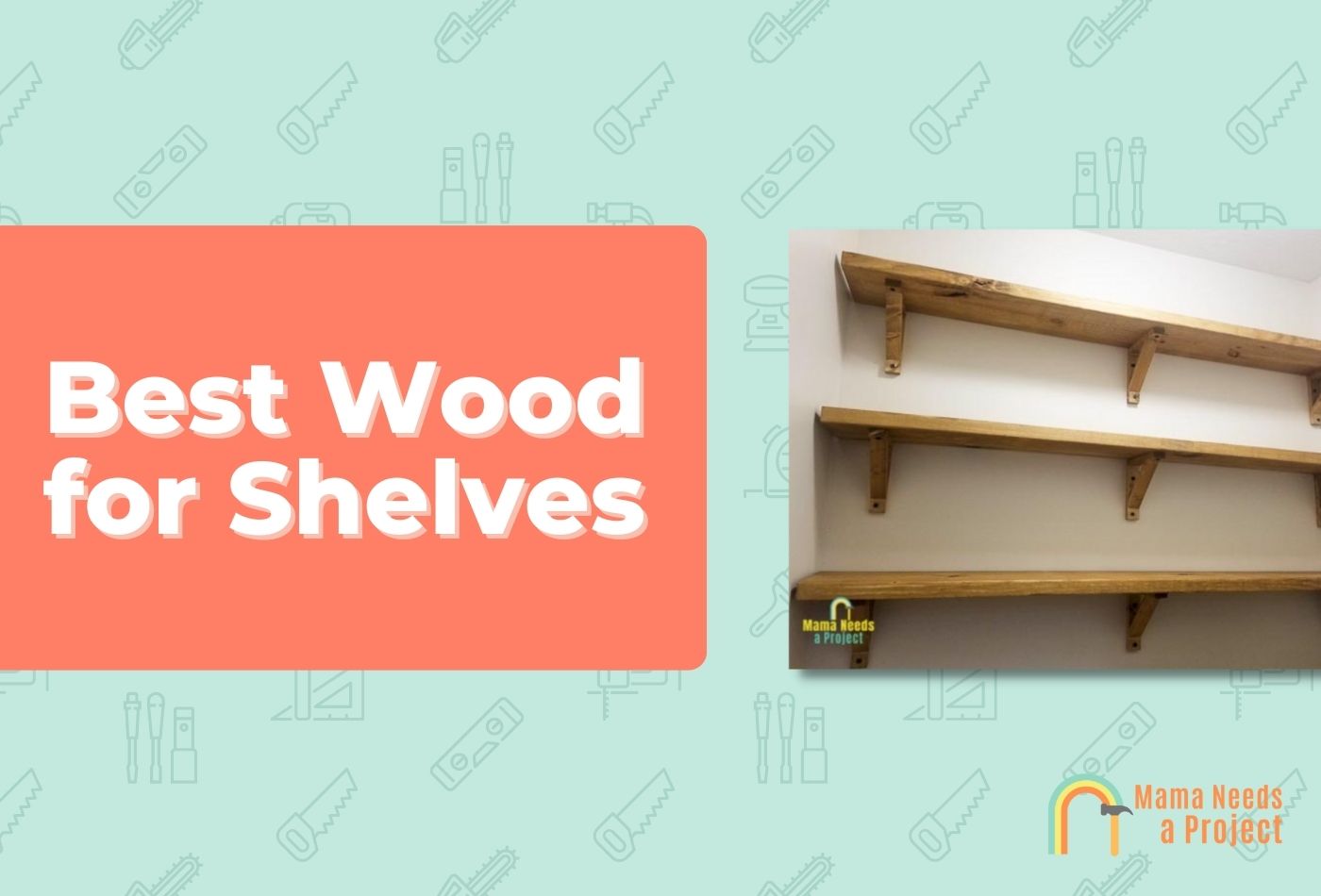Best Wood for Shelves (7 Best Woods to Use)
If you’ve worked on any sort of DIY home improvement project, chances are you’ve run into shelves or shelf-building at some point.
Shelving is a super practical, handy fixture found in almost every home. Not only are shelves useful for storing and organizing items, but they can also serve as beautiful objects for displaying and organizing your decor, books, or art pieces.
While there are many different types of materials used for shelving fixtures, I’m going to focus on my favorite – solid wood!
In this post, I’ll explore the best wood for shelves so you can make the perfect shelves for your room. Let’s get started!
- There are various types of shelving styles, including floating shelves, fixed bracket, adjustable, freestanding, built-in, and pull-out.
- The best wood for shelves include cherry, birch, maple, Douglas fir, red oak, and walnut.
- The strongest wood for shelves include walnut, red oak, koa, maple, and Santos mahogany.
Best Wood For Shelves

Wondering what to use to build wooden shelves? Here are some of the best options that account for strength and durability, relative ease to work with, and the most attractive wood.
Not only can this help you know which wood types are best for making shelves, but it can also assist you if you’re simply purchasing pre-built shelving from a home improvement store.
1. Cherry Wood
Cherry is a beautiful wood for shelving. As a hardwood and high grade wood, with a fine, straight grain and a hardness rating of 995 lbf, cherry is sturdy wood that will hold up well under weight over time.
If you’re looking for a stunning solid wood with lots of dimension that you don’t have to paint, cherry wood is an excellent choice. It comes in a gorgeous variety of rich reddish-brown tones. Cherry lumber is also lightweight and easy to cut.
Pros of cherry wood for shelving:
- Easy to shape, cut, and handle
- Beautiful enough to be left unfinished
- Strong and durable
Cons of cherry for shelving:
- More expensive to purchase than other wood types on this list
- Often darkens with age (pro or con, depending on your taste!)
2. Birch Wood
Birch is a good wood for wood shelving, and a very popular choice for all types of wood furniture and cabinetry. It’s affordable, sturdy, resists decay, and polishes well.
This light-colored hardwood has a hardness score of 830 lbf, making it a durable wood similar to maple or alder wood, but soft enough to be easy to work with.
It’s also a really budget-friendly choice, with a straight, smooth grain that looks quite nice when stained. Birch looks lovely painted, as well and it’s a great wood for desks.
Pros of birch shelving:
- Low-cost wood option compared to other hardwoods
- Can easily absorb paint
- Has a similar grain and look to maple
Cons of birch shelving:
- Can warp and crack in really dry climates
- Quality depends on birch variety: Baltic birch is expensive but more durable, whereas birch plywood is cheap but warps more easily
3. Maple Wood
Maple is an excellent choice of wood for shelves. Maple is another hardwood, with a nice lighter tan-cream color that looks very similar to birch.
Maple is a durable, strong wood. It generally has a straight grain, but you can find some nice variations like wavy, curly, tiger, or flame.
The hardness score of maple is about 1450 lbf, meaning it’s up for the task of staying strong and solid under the weight of heavier items which is why it’s also a great wood for mallet making.
Maple also has a higher density than similar alternatives like oak, and a smooth, uniform grain that makes staining outcomes consistently nice.
Pros of maple shelving:
- Has a beautiful grain that looks great stained or wood dyed
- Really durable, strong, and climate resistant
- Is a very dense wood, which will prevent warping and bowing over time
- Easy to find maple lumber, and one of the most affordable for this level of durability
Cons of maple shelving:
- While it looks beautiful when stained properly, it’s not a beginner-friendly wood to stain
- Doesn’t have much variation in grain patterns, if that’s what you’re looking for
4. Douglas Fir Wood Shelves
Douglas fir wood is another good wood choice for wood shelving. This gorgeous high quality softwood is light brown with some red and yellow streaks.
It’s a relatively affordable alternative to hardwood options like oak, and with a quality stain job it can take on that lovely hardwood appearance.
Douglas fir also machines well, but is a little fuzzy and can blunt sharp blades.
Since Douglas fir is a softer wood than some of these other options, you won’t want to overload it with heavy items. This might cause it to warp over time.
Pros of Douglas fir shelving:
- Cheaper than some hardwood options like oak
- Climate resistant, strong, and durable
- Beautiful wavy grains with subtle streaks of red and yellow
- Looks visually stunning with stain
Cons of Douglas fir shelving:
- More expensive than other softwoods like pine
- Not the easiest wood to work with and manipulate
- Somewhat prone to damage and losing its shape due to large pores
5. Red Oak Wood Shelves
Red oak (or white oak, for that matter) is an ideal wood for constructing gorgeous shelving or making bookshelves, as a highly versatile material.
This hardwood has a Janka hardness rating of 1290 lbf, making it slightly less hard than maple but one of the harder options.
That means red oak will hold up beautifully over time, offer a very stable structure for your items, and still look good years from now.
Red oak, as the name suggests, has a stunning reddish color with a stark wild grain structure. This is not the wood to cover up with paint – instead you’ll want to enhance its incredible grain with stain or varnish. It’s a great wood for staining making it perfect for shelving.
Pros of red oak shelving:
- Very hard, durable, and strong wood
- Beautiful, wild grain patterns that can be enhanced with stain
- Highly moisture-resistant, making it perfect for kitchen or bathroom shelving
Cons of red oak shelving:
- Not quite as hard as White Oak, making it more vulnerable to dents
- Somewhat expensive compared to alternatives
- Much heavier and denser, making it tougher to lift and work with
6. Mahogany Wood Shelves
Mahogany wood is one of the best woods for shelves, for oh-so many reasons. Mahogany is an exotic hardwood that’s super durable and highly workable, with rich reddish brown hues that’s to die for.
For these reasons, plus the fact that it’s not as easy to come by and ages beautifully, mahogany is definitely the most luxurious wood on this list, and a highly sought after wood.
Due to its hardness and straight, uniform grain, mahogany doesn’t easily warm or deform. If you want the maximum longevity out of your shelving and have the money to invest, look for Santos mahogany, with a crazy-high Janka hardness rating of 2200.
Mahogany shelves will hold up for years, and truly enhance the elegance of any room you install them in. Oh, and I’m begging you not to paint this elegant material. Pretty please.
Pros of mahogany shelving:
- Termite resistant, moisture resistant, climate resistant
- Highly stable and really hard
- Luxury wood for upscale home furnishing
Cons of mahogany shelving:
- Expensive materials, harder to come by
- Distinctive color that’s hard to change if you don’t want a reddish toned wood
- Heavy, hard to install and lift
7. Walnut Wood Shelves
And last but definitely not least, walnut wood shelves. Walnut is a very common, very popular wood material used for shelving and other furniture.
Walnut also makes for a great cutting board, and antique collectors love it for its elegant shelf display qualities.
Because walnut is a hardwood with a Janka hardness rating of 1010 lbf, walnut shelves will hold up nicely over time. Just make sure you don’t overload it with excessive weight, as it’s on the softer side compared to other wood species.
Walnut also has great workability, making it easier for you to handle, cut, and even carve. Similar to maple and pine, it’s a solid choice for less experienced DIYers.
Finally, if you’re going for a more dimensional, richer color wood selection, walnut is a good choice. Walnut woods range from lighter browns to dark browns.
The only thing to note is walnut color may change as time goes on, taking on more honey-yellow tones. But maybe that’s a pro to you!
Pros of walnut shelving:
- Widely available type of lumber
- Looks beautiful with an oil finish
- Sturdy enough to hold objects well for years
Cons of walnut shelving:
- One of the most expensive domestic hardwoods
- Can have dark-to-light variations in color on a single piece of board
- Isn’t the hardest wood available, and may not be the top choice for very heavy objects
Types of Wood Shelving

Wondering what types of wood shelving exist out there in the interior design-osphere?
Here are some of the most common types of shelves for your home. This will help you pick what style is most functional for your needs:
Floating Shelves
Floating shelves are all the rage these days! These are shelves that can be mounted on a variety of walls, and take up minimal space.
Their unique flavor is in the fact that they appear to be floating, with no visible hardware attaching them to the wall.
This chic modern shelving style comes in different formats, from boxes and cubes, to single-board or live edge wood pieces.
Floating shelves are quite affordable, and ideal for displaying beautiful items like books, picture frames, vases, plants, or even kitchenware sets.
Fixed Bracket Shelves
Fixed bracket shelves are quite similar to floating shelves, but their wall brackets are visible. This is a great choice if you want to spruce up the floating-shelf look with decorative gold or bronze hardware.
OR if you’re a crafty woodworker or ambitious DIYer, you can actually make your own open shelf wood brackets!
Fixed bracket shelves may be slightly more expensive than floating shelves, but are still an affordable indoor shelving option for taking your interior design to the next level.
Adjustable Shelves
Adjustable shelves are typically wall-mounted, and often used as closet shelves. The cool thing about adjustable shelves is, as the name suggests, you can adjust the vertical height of each individual shelf using the slotted hardware that attaches them to the wall.
These shelves can be open-style, but they’re also commonly found inside kitchen cabinets as pantry shelves. These are great if you have tall objects that need storage, like stacks of pots or dishes.
Adjustable slot shelves are also commonly used in garage spaces, because many models you can purchase are build to hold heavy-duty items.
Freestanding Shelves
Freestanding shelves is a broad (and popular) category of shelving. This type of shelving involves a fixture that doesn’t attach to any walls.
It can be moved, shifted, and adjusted without installation or de-installation.
Freestanding shelves come in a wide variety of models, sizes, colors, and prices.
Examples include models like freestanding tiered bookshelves, ladder-leaning bookshelves, corner bookshelves, or basic storage shelving (which is actually pretty simple to make yourself!).
I’ll be covering some useful DIY tips for freestanding shelves like these later on.
Built-in Shelves
Built-in shelves are shelves that are installed directly into the wall of a home. They are essentially a series of alcoves or nooks.
Built-in shelves almost look like bookcases that have melted into the wall. Built-in shelves cannot be easily moved or modified, since they are now a fixed component of the interior.
This means a few things: built-in shelves can be a great selling point in a home, since they look sophisticated and can hold a lot more weight than typical freestanding shelves.
But this also means you can’t just simply install them with a few screws, like you can with floating shelves. When it comes to installing built-in shelves, you may want to hire a professional.
Pull-out Shelves
Pull-out shelves are very reminiscent of cabinet drawers, but more shallow.
This style of shelf allows each individual shelf to extend outward on a track from the cabinet, making it easier for you to see what’s inside and get what you need.
Pull-out shelves can be highly functional in rooms like kitchens and offices.
Natural Vs Engineered Wood for Shelving
All we’ve discussed so far is natural solid wood for your shelving. But what about other wood options? It seems to be popping up a lot on your internet search for shelves.
Let’s talk about the difference between choosing engineered wood for your shelves, and choosing natural wood.
Choosing Engineered Wood
Choosing engineered wood for your shelves is an option many people go with. Engineered wood will include things like MDF (medium density fiberboard), or plywood.
The benefit of MDF is that it’s easy to cut and shape yourself, and can look neat when assembled. But you’ll want to be wary of using it for heavy loads. MDF is porous and soaks up moisture easily, meaning it’ll bloat overtime and get weaker.
Plywood is another type of wood for making wood shelves. Plywood is made up of layers of veneer glued together with pressure and heat to form panels.
Plywood is an affordable option and easy to work with. But keep in mind, there are different plywood grades with varying durability.
You’ll want to shell out for AB-Grade hardwood plywood for the type of shelving that really needs strength and weight-bearing capacity.
Choosing Natural Wood
Choosing natural wood for your shelving has so many benefits. While many natural woods are somewhat tougher to shape and cut than engineered wood, and typically cost more, they are made to last.
Natural wood looks far more beautiful than engineered wood (IMO), with unique grain patterns and varying colors that can really enhance your interior design.
Woods to Avoid when Building Shelves
When it comes to woods to avoid when building shelves, I’d recommend avoid wood that’s engineered, like particle board, MDF, or plywood. I’d also steer clear of softwoods, with the exception of Douglas fir.
To me, there’s a little too much uncertainty in the strength and longevity of these materials under the weight of your kitchenware, art, books, or garage supplies.
If you’re investing the money and time into building shelving yourself, you don’t want it to warp and crumble in a couple years!
Selecting one of the hardwood options above will ensure a beautiful home fixture that lasts, and still looks gorgeous years from now.
Strongest Wood for Shelves
Looking for the strongest wood for shelves? Here are the hardest of the hardwoods!
- Walnut: Janka hardness rating of 1010.
- Red oak: Janka hardness rating of 1290.
- Koa (Tigerwood): Janka hardness rating of 1220.
- Maple: Janka hardness rating of 1450.
- Santos mahogany: Janka hardness rating of 2200.
Solid Wood Bookshelf DIY Construction
Now that you know the best wood for shelves, you’re ready to tackle that wood bookshelf DIY project. If you’re searching for the best wood for bookshelves, you can’t really go wrong with any on this list.
But out of these options, walnut wood, mahogany, and koa (aka tiger wood, a bonus option!) are all popular choices.
If you’re ready to start constructing your first DIY solid wood bookshelf, you’ll need some tools.
PS: If it’s your very first time building a bookshelf and you just want to practice, grab some pine or poplar wood boards for your first trial-run. It’s cheap, no-fuss, light, and easy to work with. It’s a great starter wood for kids or children’s furniture, too.
Recommended Tools & Materials for Bookshelf Construction
Tools
- Orbital sander or sandpaper
- Table saw
- Miter saw
- Ear protection and safety goggles
- Hammer
- Router
- Tape measure
- Framing square
- Drill bit
- 45-degree chamfer bit
- Power drill
- Clamps
- Veneer trim
- Biscuit joiner
Materials
- Pencil
- Wood glue
- Screws
- Flat washers
- Finishing nails
- Paintbrushes
- Paint or stain
- Wood lumber of choice!
Check out the video below for more info!
FAQs
What Is The Best Wood To Use For Floating Shelves?
The best wood to use for floating shelves include hardwoods that are solid and durable with a tight grain, making them resistant to bowing, warping, or being ruined overtime by varying climates. Woods like koa, mahogany, red oak, walnut, and maple make for gorgeous floating shelves.
What is the best wood for shelves that won’t sag?
If you’re especially concerned with your shelves sagging, avoid softwoods and engineered woods. Look for hardwoods with a Janka hardness rating on the higher end of the scale, like mahogany, oak, and maple.
How thick should wood be for shelves?
The standard wood thickness is ¾-inch, but when it comes to durable solid wood shelving, you can opt for an even thicker piece of wood in the 1 ¼ to 3-inch thickness range.
Final Thoughts
There are so many options out there, but solid hardwoods tend to be the best options for shelving that lasts and looks stunning, without warping or crumbling after years of wear and tear.
From oak, maple, and Douglas fir, to cherry, maple, and mahogany, I know you won’t regret picking one of these gorgeous materials for your new shelving fixture.
And if you want to try your hand at building your own DIY bookshelf, there are some basic tools and materials you’ll need like a table saw, sander, paintbrushes, and paint or stain.
I’d recommend opting for a hardwood when building your own DIY bookshelf, as hardwoods can withstand the weight of your beloved library.

Jessica Vaillancourt is a freelance writer and blogger obsessed with the Travel, Wellness, and Personal Development industries.
She has 5+ years of experience helping human-first agencies, global companies, and entrepreneurs crush their content marketing goals, and serve more people. Jessica’s work has appeared on leading websites like UpgradedHome.com, BetterHelp.com, and TheDiaryofaNomad.com.
Today, her sole focus (besides finding the world’s best coffee shop) is writing to serve humans, and slow traveling abroad to expand her mind. You can get to know her work at JessAnneWriting.com.

